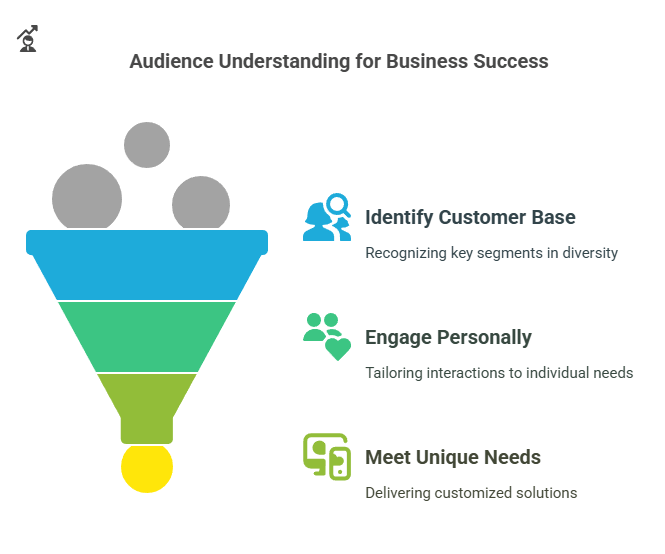Cracking the Code: How Understanding Your Audience Drives Business Success in India
Understanding the Indian Market: A Diverse Landscape
Introduction: Why Understanding Your Audience Matters in India
When it comes to running a successful business, one of the golden rules is to know your audience. In India, this is especially important. With over 1.4 billion people, a rich diversity of cultures, languages, and lifestyles, understanding your audience can make or break your business. The key to cracking the code of business success lies in identifying the right customer base, engaging them in a personalized way, and meeting their unique needs and desires.
In this article, we’ll explore why understanding your audience is vital in India, how to go about it, and how it can directly influence business success. Let’s dive in.
Understanding Your Audience

1. The Power of Diversity in India’s Market
India isn’t a single monolithic market. Instead, it’s made up of various sub-markets, each with distinct preferences and purchasing behaviours. Whether it’s the urban metros like Mumbai and Delhi or rural towns in Uttar Pradesh and Bihar, businesses must appreciate the unique nuances of each segment.
1.1 Urban vs Rural Divide
Urban consumers tend to have higher purchasing power and access to global brands, while rural consumers may prioritize practicality and affordability. This divide means businesses need tailored approaches for each segment to succeed.
1.2 Regional Differences: Language and Culture
India’s linguistic diversity is staggering, with over 22 official languages and thousands of dialects. Cultural practices, food preferences, and lifestyle choices also differ greatly from one region to another. A one-size-fits-all approach doesn’t work in India, which is why businesses must localize their strategies.
The Importance of Knowing Your Audience
2. Why Understanding Your Audience is Crucial for Business Success
2.1 Building Customer Loyalty
When businesses understand what their customers need, they can deliver personalized experiences that build loyalty. Customers are more likely to return if they feel a brand genuinely understands them.
2.2 Effective Marketing Strategies
Knowing your audience allows you to craft targeted marketing campaigns. Instead of broadcasting a generic message, you can create personalized ads, promotions, and content that resonate deeply with specific groups.
2.3 Optimizing Product Offerings
Understanding what your customers value allows you to design products that meet their exact needs, rather than creating something and hoping it will sell. Tailored products often have higher demand and higher perceived value.
How to Understand Your Audience in India
3. Conducting Market Research: The First Step
3.1 Surveys and Polls
One of the simplest ways to gather direct feedback from customers is through surveys and polls. Whether online or offline, these tools can provide valuable insights into consumer preferences, purchasing behaviour, and even satisfaction levels.
3.2 Focus Groups
In addition to surveys, focus groups give you in-depth qualitative data. These small, intimate groups allow you to explore consumers’ emotional triggers, motivations, and challenges.
3.3 Social Media Listening
With social media becoming a massive part of everyday life in India, platforms like Instagram, Twitter, and Facebook provide an opportunity for businesses to track real-time conversations, sentiment, and trends.
Segmentation: Breaking Down Your Audience
4. Demographic Segmentation: Age, Gender, Income, and Education
India has a huge young population, with nearly 50% under the age of 25. Age, gender, income, and educational background play a huge role in shaping consumer behaviour. Segmenting your audience based on these factors helps you understand how to target the right people with the right product at the right time.
4.1 Targeting Gen Z and Millennials
Younger consumers in India are tech-savvy, brand-conscious, and highly active on social media. They care about trends, sustainability, and authenticity, which is important when tailoring your products or marketing messages.
4.2 The Role of Family in Consumer Decisions
In India, family-oriented values play a significant role in consumer behaviour. Many purchasing decisions are influenced by family members, so businesses should consider family-centric marketing strategies.
5. Psychographic Segmentation: The Why Behind Their Buying Choices
Beyond just demographics, psychographics help understand why your customers make certain decisions. These include factors such as personality, values, interests, and lifestyles.
5.1 The Value of Tradition and Modernity
Indian consumers are often torn between maintaining traditional values and embracing modern influences. A savvy brand can strike the right balance, offering products that cater to both worlds.
5.2 Social Status and Aspiration
In India, social status can be a key driver of consumer behaviour. Consumers may be drawn to products that signal their success or upward mobility, making aspirational marketing an effective strategy.
Engaging Your Audience: From Awareness to Loyalty
6. Building a Brand Identity that Resonates
6.1 Authenticity Matters
Consumers in India, especially millennials and Gen Z, value authenticity. They’re more likely to engage with brands that are transparent, genuine, and socially responsible.
6.2 Storytelling in Marketing
In India, storytelling resonates deeply with consumers. Brands that weave cultural stories or personal narratives into their marketing strategies create stronger emotional connections with their audience.
7. Offering Value and Convenience
7.1 The Role of Discounts and Deals
Price sensitivity is high in India, especially in tier 2 and tier 3 cities. Offering promotions, discounts, or value packs can drive sales and attract price-conscious customers.
7.2 Easy Accessibility
With the rise of e-commerce, accessibility has become a critical factor. Businesses that offer a seamless online and offline experience—whether it’s easy navigation, reliable delivery, or customer service—tend to see better customer retention.
The Impact of Technology on Understanding Your Audience
8. Digital Transformation and Data Analytics
8.1 Leveraging Big Data
With more people online, businesses now have access to vast amounts of consumer data. By using analytics, businesses can track behaviours, preferences, and trends, allowing for even more precise audience targeting.
8.2 The Role of AI and Machine Learning
Artificial intelligence (AI) can be a game-changer in understanding your audience. By analysing customer data, AI can predict future buying behaviours, suggest personalized products, and improve customer service experiences.
Challenges in Understanding Your Audience in India
9. Overcoming Cultural and Language Barriers
9.1 Language Localization
With multiple languages spoken across India, localizing content for each region is essential. Brands must translate their messaging not only into different languages but also adapt it to the local culture.
9.2 Bridging the Rural-Urban Gap
While urban consumers may be tech-savvy and well-informed, rural consumers may be less familiar with digital tools and trends. Businesses must bridge this gap by providing both traditional and digital marketing strategies.
Conclusion: The Future of Audience Understanding in India
Understanding your audience isn’t just a one-time effort. It’s an ongoing process that requires businesses to stay updated on changing preferences, new technologies, and shifting cultural trends. As India continues to evolve, businesses that invest in understanding their diverse customer base will thrive, establishing a loyal following and gaining a competitive edge.
The key takeaway? Whether you’re selling to the high-tech urban elite or the value-conscious rural consumer, understanding your audience is the most powerful tool in your business toolkit.
FAQs
1. How do I segment my audience in India?
Segment your audience based on demographics (age, income, education) and psychographics (lifestyle, values). Use surveys, social media listening, and focus groups to gather insights.
2. Why is language important in India’s market?
With multiple languages spoken across India, using localized language in your marketing ensures your message resonates with different regions, helping you connect with your audience better.
3. What are the key challenges businesses face in India?
Cultural and language diversity, rural-urban divides, and varying levels of technology adoption are some of the main challenges businesses face in understanding their audience.
4. How can data analytics improve audience understanding?
Data analytics helps track consumer behaviour, allowing businesses to predict trends, personalize offerings, and target the right customer segments effectively.
5. How do I keep up with changing audience preferences in India?
Regular market research, staying active on social media, and using data analytics tools can help you stay on top of evolving consumer preferences in India.
6. Why is understanding your audience critical for business success in India?
Understanding your audience in India is essential because of the country’s vast diversity in terms of culture, language, and regional preferences. Tailoring your products, marketing, and customer service to the needs of different consumer segments helps build stronger relationships, improve customer loyalty, and boost overall business success.
7. How can businesses effectively segment their audience in India?
Businesses can segment their audience in India by analysing key factors like demographics (age, income, education), geography (urban vs. rural), and psychographics (lifestyle, values, and interests). Market research tools such as surveys, focus groups, and social media listening are essential in gaining insights to create personalized offerings.
8. What challenges do businesses face when trying to understand their audience in India?
The biggest challenges businesses face in India include the cultural and linguistic diversity across regions, the urban-rural divide, and the varying levels of digital access. Businesses must adapt their marketing strategies to cater to these diverse groups and overcome these barriers to engage their audience effectively.
9. How can businesses use digital tools to understand their audience better in India?
Digital tools like social media analytics, website tracking, and AI-powered data analysis can help businesses gain real-time insights into consumer behaviour. By monitoring online trends and customer feedback, companies can personalize their offerings and stay relevant to their target audience.
10. How important is localizing content for an Indian audience?
Localizing content is crucial in India due to the wide variety of languages, dialects, and regional cultures. By adapting content to local languages, traditions, and preferences, businesses can connect more deeply with their target audience and build trust, leading to higher engagement and customer loyalty.
Thank you for reading this blog. Please share your feedback.







One Comment